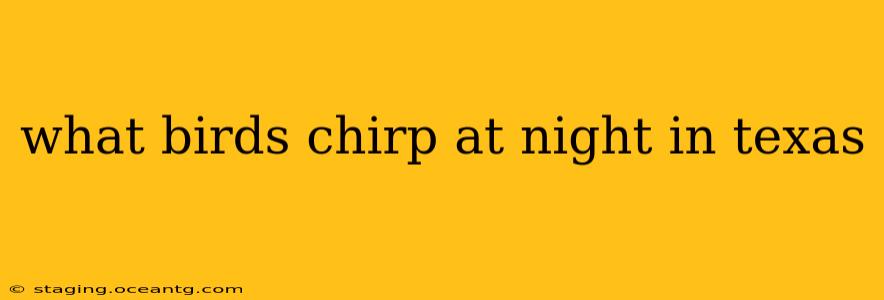Texas, with its diverse ecosystems ranging from deserts to forests, harbors a variety of bird species, some of which are surprisingly active at night. While the idea of nocturnal birdsong might seem unusual, several species in Texas produce chirps, calls, or other vocalizations after sunset. Pinpointing the exact species responsible for a night-time chirp can be tricky, as many sounds can be confused. However, we can explore some likely candidates and factors influencing their nighttime activity.
What kinds of sounds do nocturnal birds make in Texas?
Nocturnal bird sounds in Texas aren't always a distinct "chirp." Some birds produce soft whistles, clicks, or even croaks. The sounds vary widely depending on the species and the context (e.g., mating calls, territorial defense). It's less about a specific sound and more about the timing: hearing bird vocalizations at night immediately points towards a species active during those hours.
Which Texas birds are most likely to be chirping at night?
Several bird species in Texas show some degree of nocturnal activity and vocalization. Identifying them requires careful observation and listening. Here are a few possibilities:
1. Chuck-will's-widow:
This distinctive bird is known for its haunting, repetitive call, often heard at dusk and continuing into the night. The call is a series of mournful whistles and is quite recognizable. While it's not exactly a chirp, it's a common nocturnal sound in many parts of Texas.
2. Whip-poor-will:
Similar to the Chuck-will's-widow, the Whip-poor-will is a master of nocturnal vocalizations. Its name comes from its distinctive call, a series of notes sounding like "whip-poor-will." This call is most commonly heard during the breeding season, but some activity can occur throughout the night.
3. Owls:
Several owl species inhabit Texas, and their calls are undeniably nocturnal. While not technically chirps, their hoots, screeches, and other calls are frequently heard at night. The Great Horned Owl, for example, is widespread and quite vocal. Their calls, rather than chirps, are a common component of nighttime soundscapes in Texas.
4. Nightjars:
Nightjars are crepuscular and nocturnal birds, meaning they are most active at dawn and dusk and at night. They often produce buzzing, clicking, or chattering sounds. These sounds can be easily mistaken for insects. They are more likely to be heard than seen.
What other factors might affect nighttime bird sounds in Texas?
Several factors influence whether you hear birds chirping at night:
1. Time of year:
Breeding season significantly impacts nocturnal bird activity. Many species are more vocal during breeding to attract mates or defend territory.
2. Location:
The type of habitat influences which species are present. Woods, wetlands, and deserts will support different nocturnal bird communities.
3. Weather:
Temperature, wind, and precipitation can all affect bird vocalizations. Birds may be less active on cold, windy, or rainy nights.
How can I identify the specific bird making the noise?
Identifying the source of nighttime bird sounds can be challenging. However, here are some helpful tips:
- Use a bird identification app: Many smartphone apps can help identify birds by their sounds.
- Note the characteristics of the sound: Is it a chirp, whistle, hoot, or something else? How long does it last? How often is it repeated?
- Pay attention to your location: The type of habitat will help narrow down the possibilities.
- Look for the bird: Though difficult at night, try to locate the source of the sound with a flashlight.
By carefully observing and listening, and by considering the season and location, you can improve your chances of identifying the nocturnal bird responsible for those intriguing Texas night sounds. Remember to respect wildlife and maintain a safe distance when trying to observe nocturnal birds.
